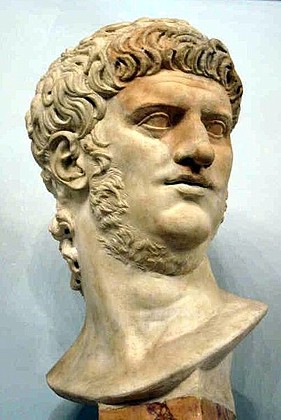
For Part 1, Introduction go here
For Part 2, Merneptah and the Book of Judges go here
For Part 3, The Problem of Solomon’s Chronology go here
For Part 4, The 430-year Sojourn go here
For Part 5, The 400 years of slavery go here
For Part 6, The Hyksos Theory go here
For Part 7, The Osarseph Theory, go here
Chaeremon, an Egyptian priest who tutored Emperor Nero, wrote a version of the Exodus story that had a number of similarities to Manetho’s Osarseph story but had enough differences to suggest that he worked from a different source than Manetho did. If so, then there would have been multiple versions of Egyptian Exodus accounts in the Egyptian libraries. You may want to first reread the Osarseph theory in Part 7 to refresh your recollection as there will be some references to that installment.
Chaeremon wrote in the first century and was a contemporary of Josephus. The latter was responsible for preserving Chaeremon’s account. (See Against Apion 1.32–33. You can read Josephus’s account and his comments here.) Here is what he says.
The next witness I shall cross-examine is Chaeremon. This writer likewise professes to write the history of Egypt, and agrees with Manetho in giving the names Amenophis and Ramesses to the king and his son. He then proceeds to state that Isis appeared to Amenophis in his sleep, and reproached him for the destruction of her temple in war-time. The sacred scribe Phritobautes told him that, if he purged Egypt of its contaminated population, he might cease to be alarmed. The king thereupon collected 250,000 afflicted persons and banished them from the country. Their leaders were scribes, Moses and another sacred scribe–Joseph. Their Egyptian names were Tisithen (for Moses) and Peteseph (Joseph). The exiles on reaching Pelusium fell in with a body of 380,000 persons, left there by Amenophis, who had refused them permission to cross the Egyptian frontier. With these the exiles concluded an alliance and marched upon Egypt. Amenophis, without waiting for their attack, fled to Ethiopia, leaving his wife pregnant. Concealing herself in a cavern she gave birth to a son named Ramesses, who, on reaching manhood, drove the Jews, to the number of about 200,000, into Syria, and brought home his father Amenophis from Ethiopia. (Against Apion, 1.32–33.)
Josephus recognizes that Chaeremon’s story is a variation of the Osarseph story but quickly points out many differences between the two, believing that to be sufficient to undermine the credibility of both. We need not itemize every inconsistency, but some are worth mentioning.
Chaeremon reiterates Manetho’s claim that the Moses faction suffered from leprosy. As previously noted, Moses and his family all suffered from leprosy.
Manetho talks about the pharaoh’s desire to “see god” whereas Chaeremon notes that the pharaoh had a vision of the goddess Isis. Both situations involve a vision of deity and in both stories the vision is connected to an expulsion of the diseased population. As noted previously, Moses also had a desire to see God.
In Manetho, the pharaoh failed to follow the advice; in Chaeremon, the advice was followed. In Manetho, the lepers made common cause with the Hyksos; in Chaeremon, they allied with an expelled army belonging to Amenophis (i.e., Akhenaten.)
In Manetho, the pharaoh’s son was five years old when Moses comes to power, and eighteen when Moses was chased from Egypt; in Chaeremon, the pharaoh’s son was an infant when Moses came to power and an adult of unspecified age when Moses was expelled.
The names in the two stories also differ slightly. In Chaeremon’s story, Amenophis’s son is called Ramesses; in Manetho, it is “Sethos also called Ramesses.” In Chaeremon’s account, the leaders of the rebellion are scribes named Peteseph and Tisithen; in Manetho, the leader is a priest named Osarseph. While the similarity between Osarseph and Peteseph is obvious, Chaeremon identifies the latter with Joseph instead of Moses.
This inconsistency, however, may be due to Chaeremon’s observation of the similarity of the names Joseph and Peteseph. Chaeremon’s version does include Moses as a co-leader, though. On the other hand, in the bible, Moses and Joseph are not contemporaries. The enslavement began after Joseph’s death and the Exodus substantially later.
Egyptologist Donald Redford suggests that the differences between Chaeremon and Manetho indicate that Chaeremon’s version is a “contaminated descent, not a free and equal variant.” That the two are different, though, proves nothing about which, if any, is the more contaminated.
Redford appears to give Manetho preference because Manetho is earlier than Chaeremon and therefore closer to the original source. But the version of Manetho that we have comes from Josephus, contemporaneous with Chaeremon, and his version of Manetho is already highly corrupted. Josephus had two inconsistent versions of Manetho, had a badly mixed up king sequence, was poorly informed about the chronological sequences pertaining to Akhenaten and Sethos, and had no idea that the Osarseph story belonged with the pharaohs of the Eighteenth Dynasty.
Chaeremon worked at the library at Alexandria and had access to its resources. He likely quoted from a direct source, and since he and Josephus were contemporaries, Josephus’s Chaeremon quote is unlikely to have been corrupted in transmission. However, Chaeremon’s story, though based on a similar set of episodes as that in the Manetho story, stems from a different source document than Manetho’s. Who is to say which was more faithful to the original, or which source was more faithful to the original events? The two versions together, Manetho and Chaeremon, suggest that the libraries had more than one text about what happened at the time of the Exodus, and how old those sources were we don’t know.
Biblical Parallels
There is much history about the events of Akehnaten’s reign (during the Eighteenth Dynasty) and its political aftermath that one would need to know to fully appreciate the various parallels between the Manetho and Chaeremon accounts and the biblical Exodus story, more than I can cover in this brief blog post. One brief note I’ll include, though, is that not long after Akhenaten died, Pharaoh Horemheb launched a massive persecution and purge of Akhenaten’s remaining loyalists. One should also be familiar with how badly Josephus and later writers badly botched Manetho’s chronology of Egypt’s Eighteenth Dynasty. I cover all this material in great detail in The Moses Mystery.
While the Osarseph story has numerous structural parallels to the biblical account, Chaeremon’s version adds more consistency. The biblical account requires that Moses depart Egypt and then return. That occurs in the Chaeremon account–the lepers are expelled but return, with an army of Akhenaten’s former soldiers, but the return is placed at the beginning of Akhenaten’s reign rather than at the beginning of Sethos’s reign. This may be due to the confusion about when Akhenaten’s reign ended.
Another interesting coincidence concerns the number of soldiers involved in the rebel army. Chaeremon says that there were 250,000 diseased Egyptians allied with 380,000 soldiers once belonging to Amenophis, a total that corresponds to the biblical figure of 600,000 males plus a mixed multitude.
In both Egyptian stories, Akhenaten flees Egypt during the reign of the usurpers. This reflects the chronological distortion due to the misplacing of Akhenaten’s reign. Historically, Akhenaten never fled from Egypt.
In the Egyptian Exodus stories, however, it should have been Akhenaten’s forces, under Osarseph/Tisithen/Moses, who fled to Ethiopia, and the flight would have occurred at the end of Akhenaten’s reign. (That may be when Moses acquired the Ethiopian wife that caused so much trouble between him and his sister Miriam. )
These forces would be the Egyptian soldiers in Chaeremon’s account that allied with Moses. They would have been reinforced by the Asian army described as Shepherds (i.e., the Hyksos, see Part 6) in the Josephus story. However, because the Egyptian scribes mistakenly placed Akhenaten’s reign just before Sethos’s, there was no room to have a flight from Egypt by Moses after Akhenaten’s reign, a return to Egypt by Moses sometime later, and a second flight from Egypt by Moses during the reign of Sethos. So the first departure was placed at the beginning of Akhenaten’s reign instead of the end.
The reference by Josephus to “Shepherds” results from his mistranslation of the name “Hyksos”. It should means “chieftain of a foreign hill-country” but Josephus had two different Manetho manuscripts, each with a different definition of Hyksos. One translated it as “Shepherd-Kings”, the other as “captive shepherds.” It does not necessarily refer to the followers of the Hyksos kings expelled by Ahmose. When Manetho says Osarseph/Moses made an alliance with the Hyksos, it tells us nothing more than that Moses formed an alliance with some group of unspecified Canaanite or Syrian chieftains.
Historically, however, if the story were true, we can make a pretty good guess as to who these chieftains would have been. Josephus says the allies came from Jerusalem. In the time of Akhenaten, Labaya, the king of Shechem, established a large kingdom that dominated central Palestine. He and his sons who succeeded him maintained a hostile attitude to the Egyptians. Albright notes that the kingdom extended to the frontiers of Jerusalem, and the rulers of Jerusalem were troubled by his presence.
If Osarseph formed an alliance with any strong military presence in the region of Jerusalem, it would have been the Shechemites. Again, if true, this could go a long way to explaining why Shechem had such a close relationship to Israel during the conquest of Canaan.
An Akhenaten Problem
Some independent scholars have attempted to equate Moses with Akhenaten. The arguments made are often weak. No mainstream Egyptologists or biblical scholars accept such allegations.
One issue that has to be addressed is that the Egyptian stories make Akhenaten and Moses enemies and any attempts to draw a connection between them must explain why this is the case and how the historical and chronological facts surrounding Akhenaten can convincingly establish a Moses connection to this Pharaoh.
So far, we have talked about historical possibilities based on the Egyptian stories, if true. We have not yet established any actual connections between the biblical Exodus and the stories of Manetho and Chaeremon or any convincing evidence to establish any link between Moses and Akhenaten. I make such connections and provide a detailed historical and chronological analysis of the events surrounding Pharaoh Akhenaten and the Exodus in The Moses Mystery.
Coming up next: Egypt’s literary fiction templates for the Exodus stories.
